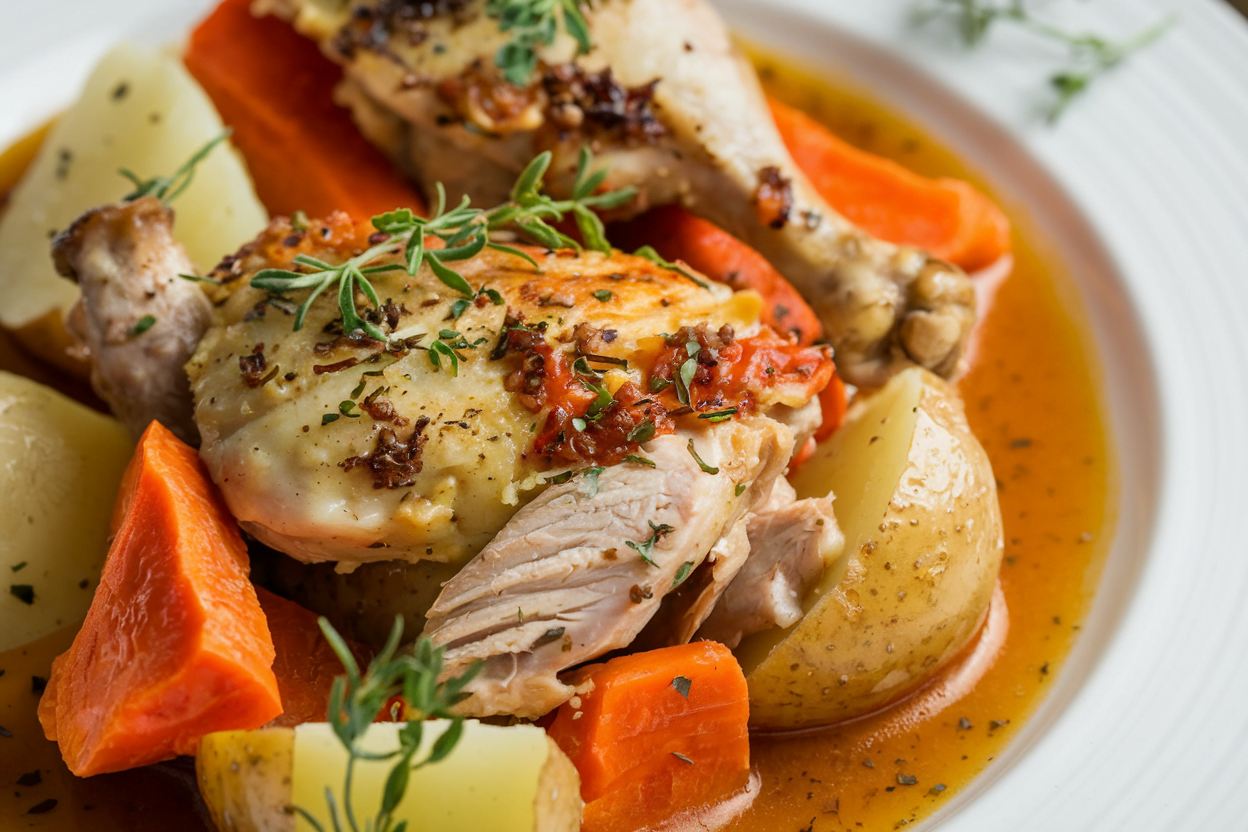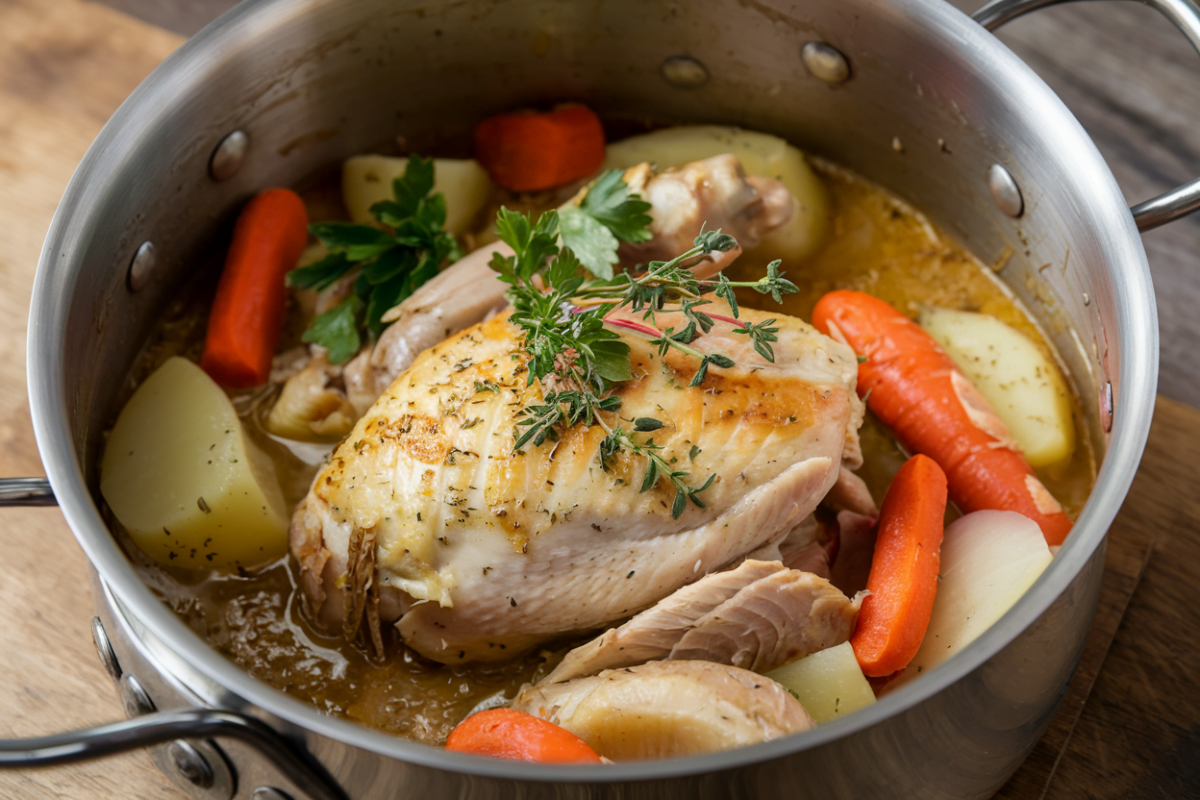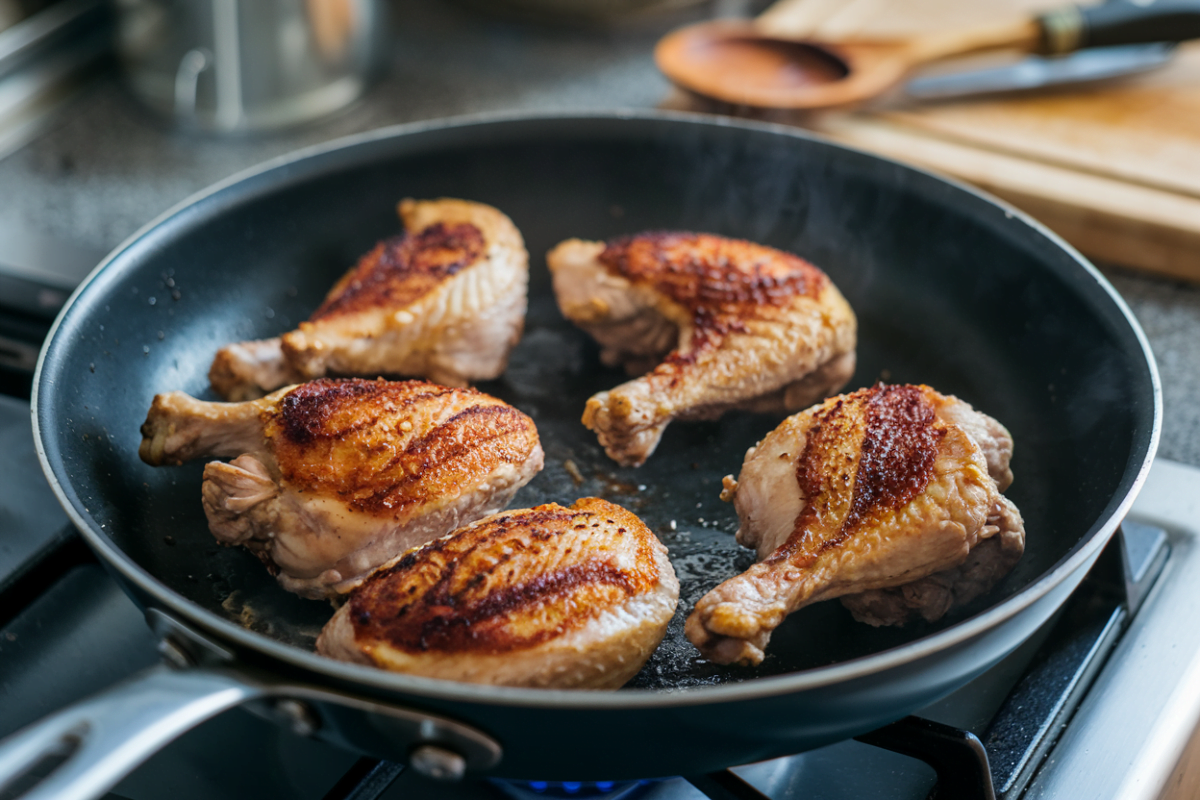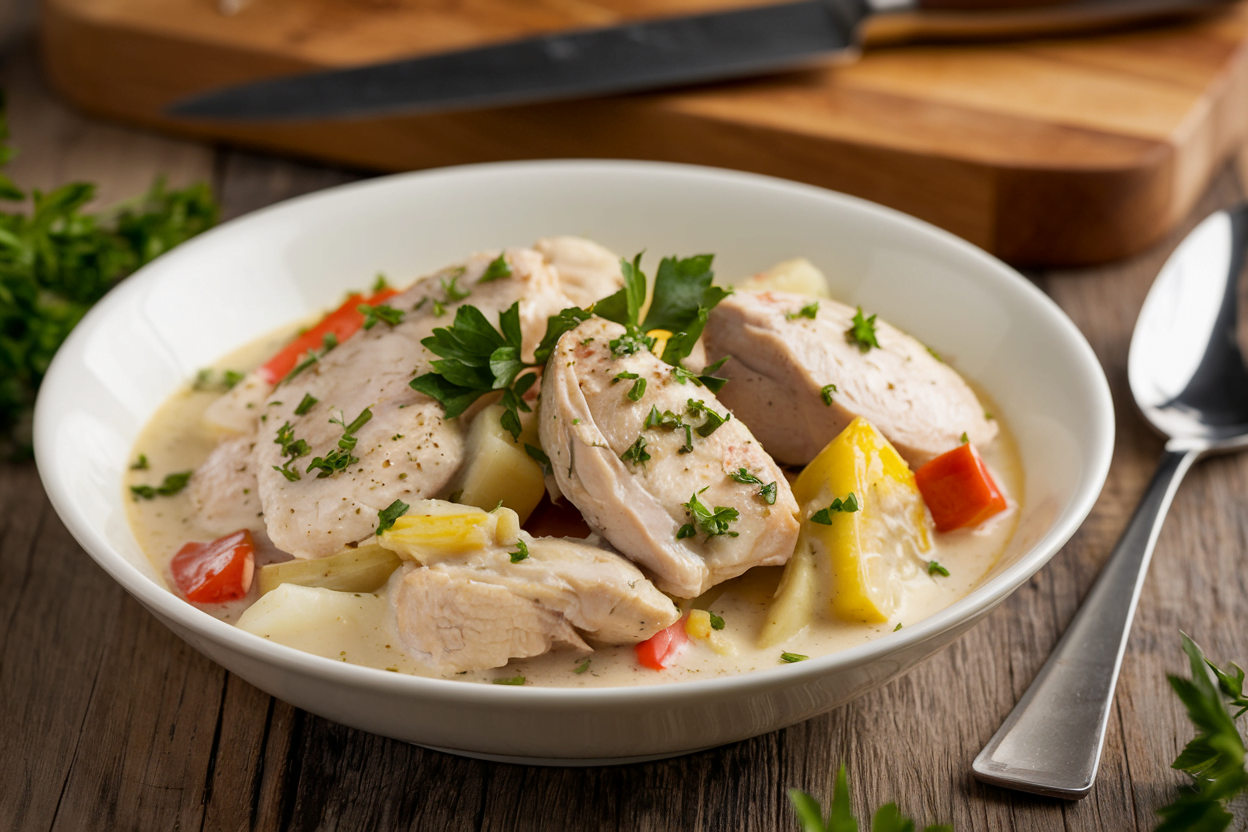Fricassee is a classic dish that has stood the test of time. It’s a staple in French cuisine, but its appeal is universal.
This dish is a comforting blend of tender meat and hearty vegetables. It’s simmered in a rich, creamy sauce that’s both savory and satisfying.
But what makes a fricassee truly classic? It’s all about the technique. The process of browning the meat, creating a roux, and slow simmering is key to its unique flavor.
In this guide, we’ll explore the world of classic fricassee recipes. We’ll delve into its history, its cultural significance, and the essential ingredients that make it so special.
We’ll also provide a step-by-step guide to making a classic chicken fricassee. From preparing your ingredients to achieving the perfect simmer, we’ve got you covered.
Whether you’re a seasoned home chef or a cooking novice, this guide is for you. It’s packed with tips, variations, and common mistakes to avoid.
So, are you ready to master the art of fricassee? Let’s get started.
What is Fricassee?
Fricassee is a traditional French dish that’s part stew, part sauté. It’s a one-pot wonder that’s known for its creamy, flavorful sauce.

The term ‘fricassee’ comes from the French words ‘frire‘ (to fry) and ‘casser’ (to break). This refers to the technique of browning the meat and then breaking it down through slow cooking.
The meat used in a fricassee is typically chicken, but it can also be rabbit, veal, or other white meats. The meat is first browned in butter, then braised in a liquid such as stock.
The sauce is thickened with a roux, a mixture of flour and fat. This gives the fricassee its characteristic creamy texture. The dish is often finished with a splash of cream and a handful of fresh herbs.
Fricassee is a versatile dish that can be adapted to suit different tastes. It can be made with a variety of vegetables, herbs, and spices. Whether you prefer it simple and traditional or loaded with extras, fricassee is a dish that’s sure to impress.
The History and Cultural Significance of Fricassee
Fricassee has a rich history that dates back to the Middle Ages. It was a popular dish among the European nobility, who appreciated its delicate flavors and creamy texture.

The dish has evolved over the centuries, with each generation adding its own twist. In France, where fricassee originated, it’s often made with rabbit or veal. In the United States, chicken is the meat of choice.
Fricassee is more than just a dish; it’s a symbol of French culinary heritage. It embodies the French approach to cooking: using simple, high-quality ingredients and cooking them with care to bring out their best flavors.
The dish has also found its way into other cuisines. In the Caribbean, for example, fricassee is a staple dish often made with chicken or fish. It’s typically spicier than its French counterpart, with the addition of chili peppers and other spices.
Despite its variations, the essence of fricassee remains the same: a comforting, hearty dish that brings people together. Whether it’s a family dinner or a festive gathering, fricassee is a dish that’s always welcome at the table.
Essential Ingredients for a Classic Fricassee
A classic fricassee recipe calls for a few key ingredients. These ingredients, when combined, create a dish that’s rich in flavor and comforting to the soul.
The star of the dish is, of course, the meat. Chicken is a popular choice, but rabbit, veal, or even fish can also be used. The meat is typically cut into pieces and browned before being simmered in a flavorful broth.

The broth is another crucial component of fricassee. It’s usually made with a combination of stock, which gives the dish its characteristic depth of flavor.
Vegetables also play a key role in fricassee. Onions, carrots, and mushrooms are common additions, but you can also add other vegetables like bell peppers or peas. The vegetables are cooked until they’re tender and have absorbed the flavors of the broth.
Here’s a basic list of ingredients for a classic chicken fricassee:
- Chicken pieces
- Chicken stock
- Onions
- Carrots
- Mushrooms
- Flour (for the roux)
- Butter
- Fresh herbs (like thyme and parsley)
Lastly, a classic fricassee wouldn’t be complete without a roux. A roux is a mixture of flour and fat (usually butter) that’s used to thicken the sauce. It gives the fricassee its creamy texture and helps to bind all the flavors together.
Step-by-Step Guide to Making Chicken Fricassee
Making a classic chicken fricassee may seem daunting, but it’s actually quite straightforward. With a little patience and the right ingredients, you can create a dish that’s sure to impress.

The first step is to gather all your ingredients. This includes the chicken, vegetables, stock, and herbs. You’ll also need flour and butter for the roux. Once you have everything ready, you can start cooking.
Preparing Your Ingredients
Before you start cooking, it’s important to prepare all your ingredients. This is known as mise en place, a French term that means “everything in its place”.
Start by cutting the chicken into pieces. Then, chop the vegetables into bite-sized pieces. Measure out stock, and gather your herbs. Having everything ready before you start cooking will make the process much smoother.
Browning the Meat
The next step is to brown the meat. This is an important step, as it helps to develop the flavor of the dish.

Heat some oil in a heavy-bottomed pot or Dutch oven. Add the chicken pieces and cook until they’re browned on all sides. Once the chicken is browned, remove it from the pot and set it aside.
Creating the Roux
Now it’s time to make the roux. This will thicken the sauce and give the fricassee its creamy texture.
In the same pot, melt some butter. Add the flour and stir until it forms a paste. Cook the roux for a few minutes, until it turns a light golden color.
Simmering to Perfection
The final step is to simmer the fricassee. This will allow the flavors to meld together and the meat to become tender.
Return the chicken to the pot and add the vegetables and stock. Bring the mixture to a simmer, then reduce the heat and let it cook for about an hour. The fricassee is done when the chicken is tender and the sauce has thickened.
Variations on the Classic Fricassee Recipe
While chicken fricassee is a classic, there are many ways to put a twist on this traditional dish. By changing up the protein or adding different vegetables and herbs, you can create a fricassee that’s uniquely yours.
For instance, you could try making a rabbit or veal fricassee. These meats have a slightly different flavor and texture, but they work well with the basic fricassee technique. Just be sure to adjust the cooking time as needed, as these meats may take longer to become tender.
Here are a few other variations you might consider:
- Use a different type of stock for the braising liquid.
- Add a variety of mushrooms for an earthy flavor.
- Make a vegetarian or vegan fricassee using plant-based proteins.
Remember, the key to a great fricassee is balance. No matter what variations you choose, make sure the flavors work well together and don’t overpower each other. With a little creativity, you can make a fricassee that’s truly your own.
Tips for a Perfect Fricassee Every Time
Cooking a perfect fricassee is not just about following a recipe. It’s also about understanding the techniques and principles behind the dish. Here are some tips to help you achieve a perfect fricassee every time.
First, don’t rush the browning process. This step is crucial for developing a deep, rich flavor in your fricassee. Make sure the meat is well-browned on all sides before moving on to the next step.
Second, be patient with the simmering process. It’s tempting to crank up the heat to get things moving, but a slow, gentle simmer is key to tender, flavorful meat. Remember, fricassee is a dish that rewards patience.
Third, taste and adjust the seasonings as you go. Don’t just rely on the measurements in the recipe. Everyone’s taste buds are different, so it’s important to adjust the seasonings to your liking.
Lastly, don’t be afraid to experiment. Once you’ve mastered the basic fricassee recipe, feel free to play around with different ingredients and flavors. After all, the best part of cooking is making a dish your own.
Common Mistakes to Avoid
While fricassee is a relatively simple dish to prepare, there are a few common mistakes that can affect the final result. By being aware of these pitfalls, you can ensure a successful fricassee every time.
One common mistake is using high heat throughout the cooking process. Fricassee requires a gentle simmer, not a rolling boil. High heat can cause the meat to become tough and the sauce to separate. Always keep the heat low and steady.
Another mistake is not properly browning the meat. This step is crucial for developing flavor. Make sure the meat is well-browned on all sides before adding the other ingredients.
Lastly, many cooks forget to taste and adjust the seasonings as they go. Remember, the recipe is just a guide. Always taste your fricassee and adjust the seasonings to your liking.
Serving and Pairing Suggestions
Fricassee is a versatile dish that can be served in a variety of ways. It’s hearty enough to stand on its own, but it also pairs well with a range of sides.
Traditionally, fricassee is served with rice or crusty bread to soak up the delicious sauce. However, it can also be served with mashed potatoes, pasta, or polenta for a comforting and filling meal.
Remember, the best pairing is one that you enjoy. So feel free to experiment and find your perfect match.
Storing and Reheating Fricassee
Fricassee is a dish that tastes even better the next day, making it perfect for leftovers. To store, simply let it cool completely before transferring it to an airtight container.
When you’re ready to enjoy it again, reheat it gently on the stove over low heat. You may need to add a splash of water or stock to loosen the sauce. Avoid boiling as it can toughen the meat. With these simple steps, you can enjoy your delicious fricassee for days to come.
FAQs About Fricassee
Fricassee is a versatile dish that can be adapted to suit various tastes and dietary needs. However, it’s natural to have questions when trying a new recipe. Here are some common queries about fricassee:
- Can I use other meats in a fricassee? Yes, while chicken is traditional, you can also use rabbit, veal, or even plant-based proteins for a vegetarian version.
- What can I serve with fricassee? Fricassee pairs well with a variety of sides, from rice and crusty bread to potatoes and pasta.
- Can I make fricassee ahead of time? Absolutely. Fricassee is a great make-ahead dish as the flavors develop even more over time.
Remember, cooking is an art, not a science. Feel free to experiment and make the fricassee recipe your own. Happy cooking!
Conclusion
In conclusion, mastering the art of fricassee can open up a world of culinary possibilities. This classic dish, with its rich flavors and comforting warmth, is a testament to the timeless appeal of traditional cooking. So, don your apron, gather your ingredients, and embark on your fricassee journey today. Happy cooking!
